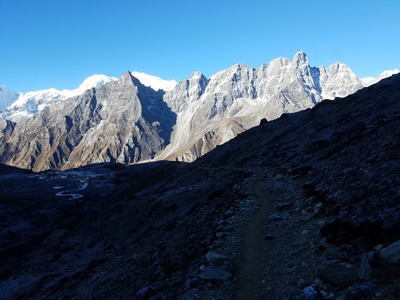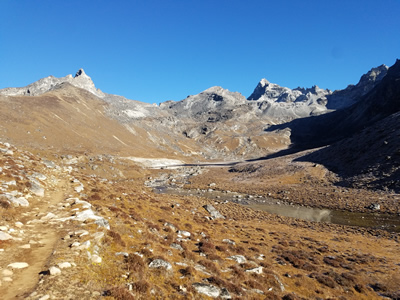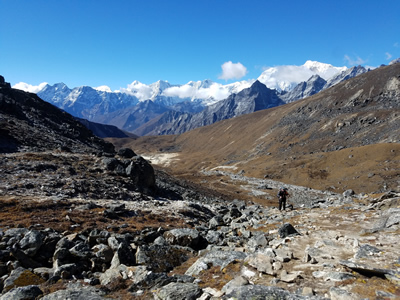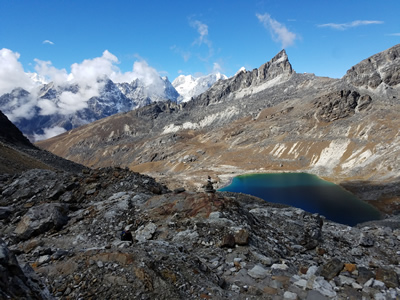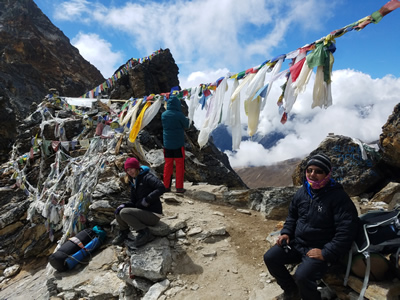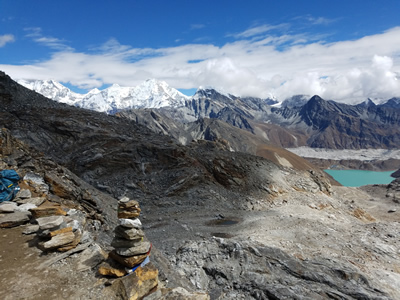Nepal Pt9: Crossing the Renjo La
Today we were going over our first high pass, the Renjo La (La is Tibetan for pass). It's seriously high at 17,585 ft. We were starting from Lumde at 14,330 ft so we had about 3250 feet to climb, not counting ups and downs. Normally I would say that's good exercise but not that hard. At lower elevations that is. At 17,000 feet it's a big deal.
We wanted to start as early as possible. To do that we had to give our breakfast order to the people at the lodge the night before. They would have it ready for us at 5 am. With my stomach problems I didn't want anything. Shambu thought that I needed something so we had a bit of an argument. He was worried that I would have problems going over the pass. So was I, but for different reasons.
I didn't have a great night but I was up at 5 am. It was still pitch dark. We left at 5:15, finding our way by headlamp. Looking above us we could see the lights of another group who had left even earlier than we did. I guess we were just slackers.
The sky was perfectly clear. That meant it was cold but I was bundled up and comfortable. We moved slowly but gained elevation steadily. It was beautiful when the sun's light hit the high snow peaks of Kungdi Ri while the valley was still in darkness.
As it got lighter the scenery changed constantly but it was always spectacular. Isolated with my hood up, the only sound my heavy breathing, I was alone with the mountains. It was amazing hiking and I was enjoying every minute of it. Oh yeah. This was worth all the effort and all the discomfort.
The view from the Renja La was supposed to be even better. It would be my first chance on this trip to see Mt. Everest. When we stayed in Monjo I talked to a trekker who was on his way home after crossing the Renjo La. He said that when he was there all the peaks had been hidden by clouds and he didn't get any view at all. I was thinking of his story this morning and hoping we could get to the pass before the clouds built up. Since it was only three thousand feet of elevation gain I figured we could make it in three hours or so which should be plenty early. Yeah, right.
It was a long climb up that first big slope, out of the Bhote Khosi Valley. It was hard work so I just took it slowly. Shambu was very patient with my slow pace this morning, as he had been every day. "Bistari, bistari" he told me. In Nepali it means "Slowly, slowly". It had been my mantra the whole trip.
We topped out in a large, uninhabited mountain basin. We had gained maybe half the elevation to the pass in about two hours and I was feeling good. A little slow maybe but not too bad.
The next section was a slow rise through the basin past a series of three mountain lakes. Although the mountaintops were all brightly lit we were still in shadow but as we crossed the basin we came out into the sunlight. It's warmth was welcome. The hiking was pleasant as we passed the lakes but it was pleasant for a long, long time. When there are no trees or buildings or anything to use to judge scale the size of the landscape, it can be deceptive. This place was big and it took a long time to reach the third lake but hey, it was only another twelve hundred feet of elevation gain to the pass. We were practically there.
When you hike over a pass, usually as you get close it's obvious where the pass is and how to approach it. You look and say to yourself "Oh, so that's where we're going". Not this time. The last lake was in a large cirque with high walls of crumbly rock all around. It was not obvious where the easy route out of the cirque was or even if there was an easy way. When I looked very carefully I could see a small notch, far above us, adorned with prayer flags and with tiny figures moving around. My reaction was "Seriously? That's the pass? That's where we're going?"
It was really hard.
Those words don't begin to convey what it was like. It was The Mother of All Hills. It was brutal work and it seemed to take forever. The altitude was having an effect and I was always out of breath, no matter how slowly I went or how often I stopped.
Bistari, bistari.
There were six or eight other groups heading up to the pass. Most of them were faster than we were but I actually passed a couple of people. Those folks were really hurting.
The slope went on and on. The higher I got, the more I slowed down. It seemed like I was asymptotically approaching the pass and would never get there. I just kept moving and saying to myself "bistari, bistari', over and over again. I was saying it in my head of course. I couldn't spare any breath to actually say it out loud. Shambu could see I was struggling and graciously offered to carry my pack but I declined. I was determined to get to the pass fair and square, no matter how long it took.
Finally after a switchback I could see that the trail led straight to the pass. I was on the home stretch. By this time I was taking ten steps and then stopping to pant and catch my breath.
Then I was there. I was at the Renjo La, at 17,585 feet.
I shuffled over to a place where I could sit down. I did nothing but breathe for a while. It took a long time to catch my breath.
I had hoped to get here before the view was obscured but it was too late for that. It had taken us six hours to reach the pass, probably a record and not the good kind. Everest and several other peaks were totally hidden. Only the tops of other big mountains were covered so the view was still impressive. It didn't matter though. On the final slope I had decided that it would be enough if I made it to the pass, whether there was a view or not.
We stayed on the Renjo La for a while, drinking a lot of water and resting up before we started again. From here it was all downhill but we still had a long way to go to reach the village of Gokyo. I was worried that I might have burned out on the big push up to the pass but it turned out that I did ok. I went slowly, of course, but did fine on the way down. Bistari, bistari. I wasn't so much hiking as shuffling all the way down. It took us two and a half hours but I made it. We had crossed the Renjo La and were in Gokyo.
